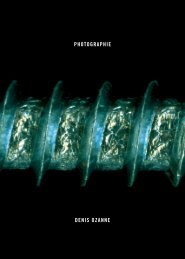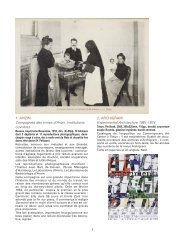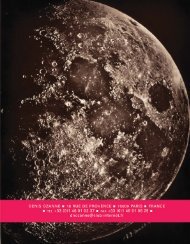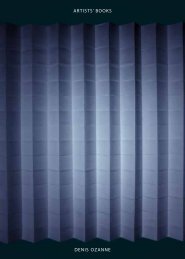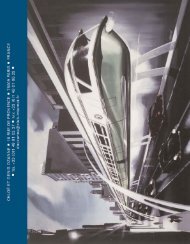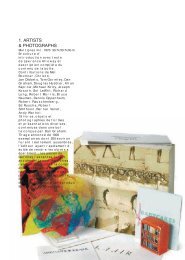Consulter - chloe et denis ozanne - rarebooks
Consulter - chloe et denis ozanne - rarebooks
Consulter - chloe et denis ozanne - rarebooks
Create successful ePaper yourself
Turn your PDF publications into a flip-book with our unique Google optimized e-Paper software.
SMS: ART IN REAL TIME<br />
It was 1968, a time to uns<strong>et</strong>tled in America that some spoke of revolution. San Francisco’s Haight-<br />
Ashbury had become nationally, even internationally, known as a haven for those attempting to turn<br />
dropped-out flamboyance into new ways of life. Political unrest produced two assassinations and would<br />
turn the Democratic National Convention into a riot. In the world of art, Color Field painting and Pop<br />
Art were reaching maturity while new developments were appearing with extraordinary rapidity as<br />
Minimalism splintered into Conceptualism, Performance Art, and Earthworks. New York’s Lower East<br />
Side was generating a new neighborhood known as the East Village. On Manhattan’s Upper West Side, the<br />
American Surrealist William Copley had leased a third-floor loft and invited his fellow artists to exercise a<br />
collaborative freedom few had experienced before or would experienced again.<br />
Lew Syken, the project’s chief designer, remembers the SMS studios as a place where “it was impossible to<br />
anticipate what would happen next. On a given day, you never knew who would show up”. It might be Pop<br />
Artist Roy Lichtenstein, Alain Jacqu<strong>et</strong>, representing French Pop, Marcel Duchamp, or Richard Artschwager.<br />
Mer<strong>et</strong> Oppenheim and Man Ray, v<strong>et</strong>erans of Surrealism and Dada, contributed to SMS. There were many<br />
others, some as renowned as Christo, Claes Oldenburg, and John Cage, others known only as the authors of<br />
works included in one of SMS’s six portfolios. Like an astronomer’s time-lapse photograph, SMS caught<br />
many bright and familiars stars. It also registered the presence of the most elusive com<strong>et</strong>s.<br />
D<strong>et</strong>ail of SMS’s complex, often round-the-clock and always chaotic working days were managed by<br />
Copley’s associate, Dimitri P<strong>et</strong>rov. Copley himself (who had made his reputation as a painter under the<br />
abbreviated signature, “CPLY”) occupied a corner office with a view of West 80th Stre<strong>et</strong> and Broadway.<br />
Here, with his long flowing hair and red velv<strong>et</strong> bell-bottom suit, he gre<strong>et</strong>ed visitors and presided over a<br />
buff<strong>et</strong> perp<strong>et</strong>ually replenished by nearby Zabar’s Delicatessen, an open bar, and a pay phone with cigar box<br />
filled with dimes. It was no small wonder that the SMS loft was a haven for both accomplished and aspiring<br />
artists.<br />
No manifesto made the claim then, so one must make it now: SMS turned art into the vehicle of Utopian<br />
wishes. First, it removed all boundaries b<strong>et</strong>ween the mediums. Everything, from po<strong>et</strong>ry to performance to<br />
traditional printmaking, received equal treatment. This principle of equality carried over to money matters:<br />
every contributor, no matter how illustrious, received a flat of $100 for his or her work. Moreover, SMS<br />
bypassed the hierarchical labyrinth of museums and established galleries. Portfolios were sent directly to<br />
subscribers on the faith that an audience put in immediate contact with art would have a direct and therefore<br />
powerful response.<br />
This faith, the foundation of the SMS Utopia, was to some extend justified. Y<strong>et</strong> some the potential audience<br />
must have felt bewildered by the prospect of receiving in the mail a h<strong>et</strong>erogeneous bundle of artworks<br />
announced but unexplained. You undid the parcel and made whatever you could of the plentitude that<br />
tumbled out. Every work has its own thoroughly independent meaning, for SMS was at its most Utopian<br />
in the respect it paid to artists’ intentions. On the other hand, the sheer lavishness of that respect for<br />
individuality generated a significance that belongs to the project as a whole. Art usually appears in spaces s<strong>et</strong><br />
aside from ordinary life by the aura of galleries and museums, and art history in somehow separate from our<br />
larger history. But SMS’s Utopian impulses overcame that separation. Sending art into the world through the<br />
mail it immersed art in the currents of real time.<br />
Because Copley ensured that money was no object to the realization of any proposal, it was possible to<br />
replicate a fragment of an artist’s oeuvre with astonishing accuracy. As just one example, Rotella’s “Six<br />
Prison Poems” written during the artist’s Roman imprisonment on drug charges, have the look and even the<br />
feel of the paper scraps on which they were clandestinely written.



